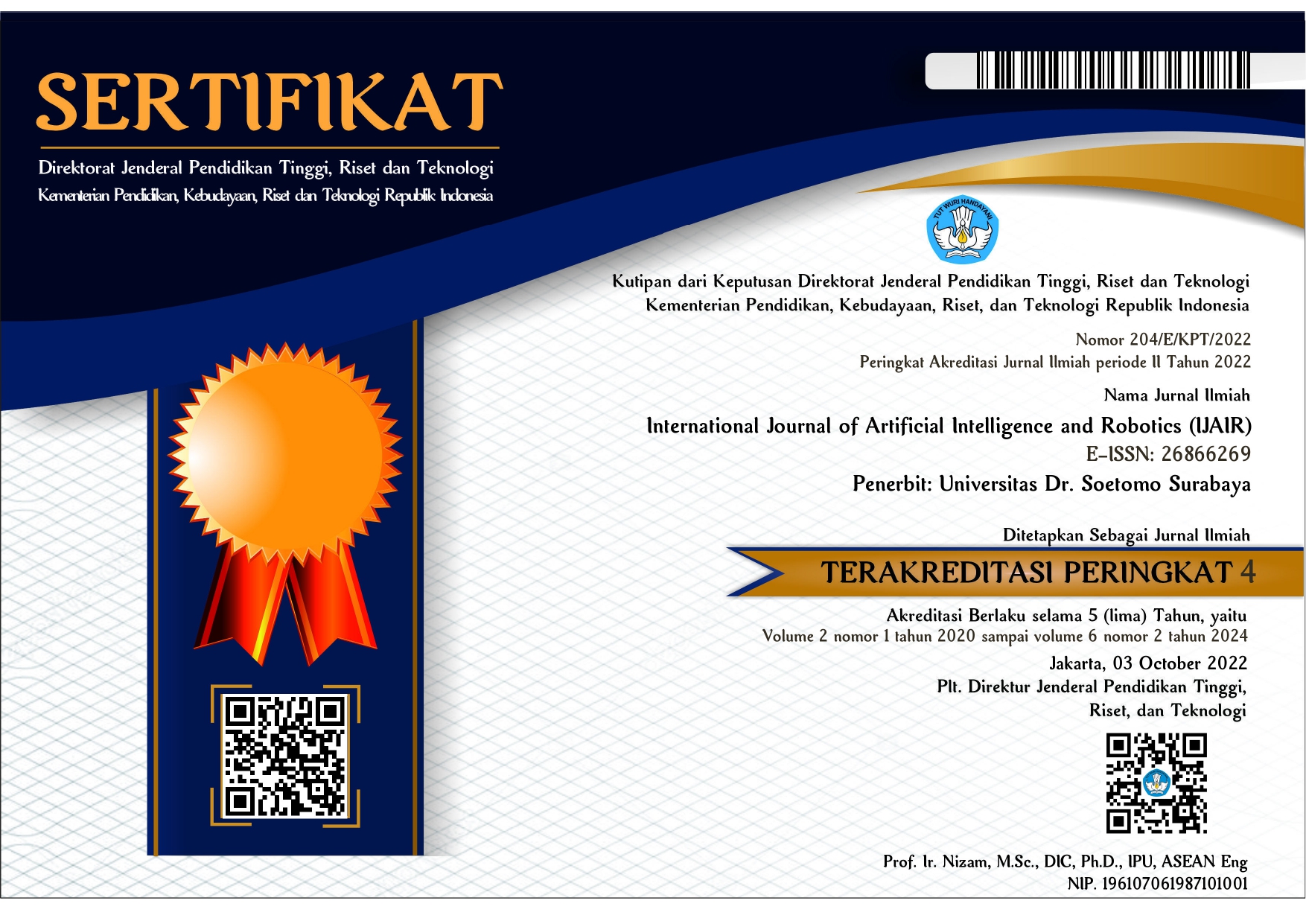Recognition of Korean Alphabet (Hangul) Handwriting into Latin Characters Using Backpropagation Method
 Abstract views: 322
,
Abstract views: 322
,
 PDF downloads: 279
PDF downloads: 279
Abstract
The popularity of Korean culture today attracts many people to learn everything about Korea, especially in learning the Korean language. To learn Korean, you must first know Korean letters (Hangul), which are non-Latin characters. Therefore, a digital approach is needed to recognize handwritten Korean (Hangul) words easily. Handwritten character recognition has a vital role in pattern recognition and image processing for handwritten Character Recognition (HCR). The backpropagation method trains the network to balance the network's ability to recognize the patterns used during training and the network's ability to respond correctly to input patterns that are similar but not the same as the patterns used during training. This principle is used for character recognition of Korean characters (Hangul), a sub-topic in fairly complex pattern recognition. The results of the calculation of the backpropagation artificial neural network with MATLAB in this study have succeeded in identifying 576 image training data and 384 Korean letter testing data (Hangul) quite well and obtaining a percentage result of 80.83% with an accuracy rate of all data testing carried out on letters. Korean (Hangul).
Downloads
References
M. Salemdeeb and S. Ertürk, "Full depth CNN classifier for handwritten and license plate characters recognition," PeerJ Comput. Sci., vol. 7, pp. 1–22, 2021.
I. J. Kim and X. Xie, "Handwritten Hangul recognition using deep convolutional neural networks," Int. J. Doc. Anal. Recognit., vol. 18, no. 1, pp. 1–13, 2015.
Rajashekararadhya, S.V. & Ranjan, P,V., "Ensemble Neural Network in Classifying Handwritten Arabic Numerals. Journal of Theoretical and Applied Information Technology," Vol. 5, 63-79, (2009).
D. A. Sani and M. Saifulloh, "Speech to Text Processing for Interactive Agent of Virtual Tour Navigation," Int. J. Artif. Intell. Robot., vol. 1, no. 1, p. 31, 2019.
M. Z. Sarwani, D. A. Sani, and F. C. Fakhrini, "Personality Classification through Social Media Using Probabilistic Neural Network Algorithms," Int. J. Artif. Intell. Robot., vol. 1, no. 1, p. 9, 2019.
Andi Wahju Rahardjo Emanuel & Arie Hartono, "Pengembangan Aplikasi Pengenalan Karaketer Alfanumerik Dengan Menggunakan Algoritma Neural Network Three-Layer Backpropagation", Jurnal Informatika, Vol.4, No.1, Juni 2008.
Delsavonita, & Candra, F., “Sistem Pengenalan Pola Karakter Huruf Korea Menggunakan Metode Principal Component Analysis dan Jaringan Syaraf Tiruan Back Propagation, “ Universitas Riau, (2018).
Siang, JJ, “Jaringan Syaraf Tiruan dan Pemrogramanya Menggunakan Matlab,” Yogyakarta, Penerbit Andi, (2009).
Prasojo, A., “Pengenalan Karakter Alphabet Menggunakan Jaringan Syaraf Tiruan,” 7, (2011).
Duslasrip, M., “PENGGUNAAN JARINGAN SYARAF TIRUAN UNTUK MENDETEKSI STATUS GIZI BALITA DENGAN METODE BACKPROPAGATION,” (2015).
Adistya, R., & Muslim, M. A., “Deteksi dan Klasifikasi Kendaraan menggunakan Algoritma Backpropagation dan Sobel,” Journal of Mechanical Engineering and Mechatronics, (2016).
Nurmilah, N., Sugiharto, A., & Sarwoko, E. A., “ALGORITMA BACKPROPAGATION NEURAL NETWORK UNTUK PENGENALAN POLA HURUF JAWA,” Jurnal Masyarakat Informatika, Vol. 1, 1, (2006).
Kusumadewi, S, “Membangun Jaringan Syaraf Tiruan Menggunakan Matlab dan Excel Link,” Yogyakarta, Graha Ilmu, (2004).
Makridakis, S dan Steven, C.W., “Metode dan Aplikasi Peramal,” Jakarta, Erlangga, (1999).
Copyright (c) 2021 Anang Aris Widodo, Muchammad Yuska Izza Mahendra, Mohammad Zoqi Sarwani

This work is licensed under a Creative Commons Attribution-ShareAlike 4.0 International License.
Authors who publish with International Journal of Artificial Intelligence & Robotics (IJAIR) agree to the following terms:
-
Authors retain copyright and grant the journal right of first publication with the work simultaneously licensed under a Creative Commons Attribution License (CC BY-SA 4.0) that allows others to share the work with an acknowledgment of the work's authorship and initial publication in this journal.
-
Authors are able to enter into separate, additional contractual arrangements for the non-exclusive distribution of the journal's published version of the work (e.g., post it to an institutional repository or publish it in a book), with an acknowledgment of its initial publication in this journal.
-
Authors are permitted and encouraged to post their work online (e.g., in institutional repositories or on their website) prior to and during the submission process, as it can lead to productive exchanges, as well as earlier and greater citation of published work.















